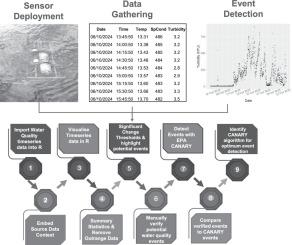通过使用R和美国环保局CANARY进行连续水质监测和时间序列数据处理,用于识别河流中水动力水质事件的开源工作流
IF 1.9
Q2 MULTIDISCIPLINARY SCIENCES
引用次数: 0
摘要
改善欧洲地表水质量需要采取紧急行动,解决扩散污染源,特别是来自农业的污染源,水文气候事件的频率和强度增加也是污染物出口到水域和全球水质下降的主要驱动因素。然而,对于采用高频水质监测的传感器部署、传感器维护和数据管理,需要全面、实用的协议,以及公民科学家在分析数百万水质数据点和共享元数据方面面临的挑战,已经得到了强调。提出的实用方法,可重复性内置于工作流程中,专为多个用户设计,并演示了工作流程的逐步应用,包括:•在两个具有不同站点特征的临时监测站部署水质探空仪的安排。•数据收集和数据验证方法。•简明、可重复、开源的工作流程,详细介绍了使用R、R markdown和美国环保署CANARY软件进行数据导入、数据清洗、数据可视化、数据完整性,以及用于检测潜在水质事件的特定地点CANARY事件系统配置。不同河流上的两个监测站的结果显示,CANARY成功地识别了100% (n 47)和97% (n 39)的人工识别浊度事件。本文章由计算机程序翻译,如有差异,请以英文原文为准。

An open-source workflow for identifying hydrodynamic water quality events in rivers by continuous water quality monitoring and time-series data processing using R and US EPA CANARY
Improving European surface water quality requires urgent action to address diffuse pollution sources particularly from agriculture, with increased frequency and intensity of hydroclimatic events also a key driver of pollutant export to waters and water quality decline worldwide.
However, the need for comprehensive, practical protocols for sensor deployment, sensor maintenance and data management for the adoption of high frequency water quality monitoring has been highlighted, along with the challenges for citizen scientists in analyzing millions of water quality data points and sharing metadata. The practical method presented, with reproducibility built into the workflow, is designed for multiple users and a step-by-step application of the workflow is demonstrated including:
- •Deployment arrangement for water quality sondes in two temporary monitoring stations with different site characteristics.
- •Data collection and data validation methods.
- •Concise, reproducible, open-source workflow detailing the use of R, R markdown and US EPA CANARY software for data import, data cleaning, data visualization, data integrity, along with site-specific CANARY event system configuration for the detection of potential water quality events.
求助全文
通过发布文献求助,成功后即可免费获取论文全文。
去求助
来源期刊

MethodsX
Health Professions-Medical Laboratory Technology
CiteScore
3.60
自引率
5.30%
发文量
314
审稿时长
7 weeks
期刊介绍:
 求助内容:
求助内容: 应助结果提醒方式:
应助结果提醒方式:


